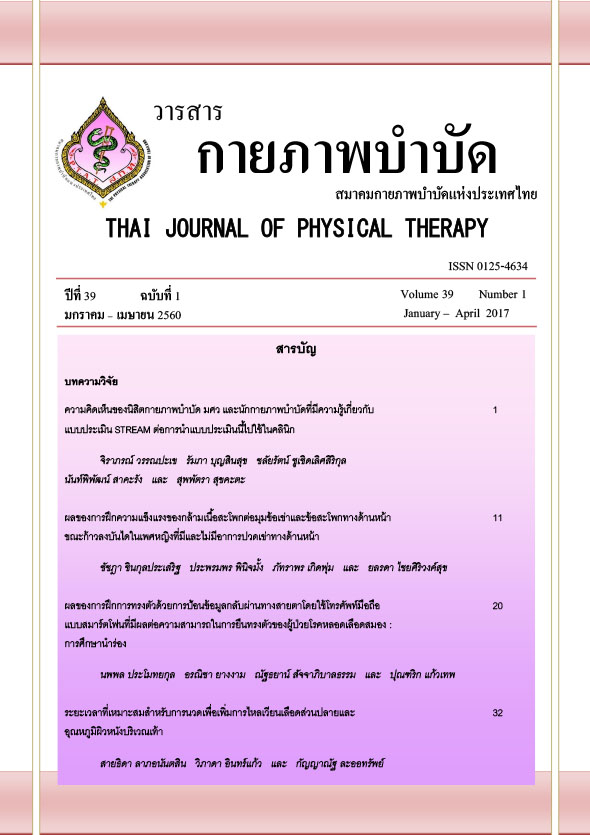ผลของการฝึกการทรงตัวด้วยการป้อนข้อมูลกลับผ่านทางสายตาโดยใช้โทรศัพท์มือถือ แบบสมาร์ตโฟนที่มีผลต่อความสามารถในการยืนทรงตัวของผู้ป่วยโรคหลอดเลือดสมอง: การศึกษานำร่อง
Main Article Content
บทคัดย่อ
ที่มาและความสำคัญ: การฝึกการทรงตัวร่วมกับการป้อนข้อมูลกลับทางสายตาช่วยให้ผู้ป่วยโรคหลอดเลือดสมองสามารถฟื้นฟูความสามารถการทรงตัวได้อย่างมีประสิทธิภาพ ปัจจุบันโทรศัพท์มือถือแบบสมาร์ตโฟนได้ถูกเริ่มนำมาใช้เป็นส่วนหนึ่งในการให้ผลป้อนกลับทางสายตามากขึ้น ดังนั้น การศึกษานี้จึงมีความสนใจที่จะสร้างแอปพลิเคชันสำหรับโทรศัพท์มือถือแบบสมาร์ตโฟนเพื่อฟื้นฟูความสามารถการทรงตัวสำหรับผู้ป่วยโรคหลอดเลือดสมอง
วัตถุประสงค์: ศึกษาประสิทธิภาพเบื้องต้นของการฝึกการทรงตัวด้วยการป้อนข้อมูลกลับผ่านทางสายตาจาก แอปพลิเคชันของโทรศัพท์มือถือแบบสมาร์ตโฟนที่มีต่อความสามารถการยืนทรงตัวในผู้ป่วยโรคหลอดเลือดสมอง
วิธีการ: ผู้ป่วยโรคหลอดเลือดสมองเรื้อรัง จำนวน 17 คน ได้รับการคัดเลือกเข้าสู่การศึกษา โดยผู้เข้าร่วมการศึกษาได้รับการฝึกการทรงตัวขณะอยู่นิ่งและการฝึกถ่ายน้ำหนักในทิศทางต่างๆขณะยืนด้วยการป้อนข้อมูลกลับผ่านทางสายตาจาก แอปพลิเคชันของโทรศัพท์มือถือแบบสมาร์ตโฟนที่พัฒนาขึ้น เป็นระยะเวลา 32 นาที ผู้เข้าร่วมการศึกษาได้รับการประเมินความสามารถการทรงตัวที่ประกอบด้วยการทดสอบสัดส่วนความสมมาตรในการลงน้ำหนัก การลงน้ำหนักผ่านขาข้าง อ่อนแรง การทดสอบ timed up and go test (TUGT) และการทดสอบ multi-directional reach test (MDRT) ก่อนและหลังการฝึก การศึกษานี้ใช้สถิติ Dependent samples t-test และ Wilcoxon signed rank test ในการวิเคราะห์ผลการเปลี่ยนแปลงที่เกิดขึ้นภายหลังการฝึก
ผลการศึกษา: ภายหลังการฝึกพบว่าผู้เข้าร่วมการศึกษามีการถ่ายน้ำหนักไปยังขาข้างอ่อนแรง ค่าการทดสอบ timed up and go test และ ค่าการทดสอบ multi-directional reach test ดีขึ้นอย่างมีนัยสำคัญทางสถิติ (p < 0.05) อย่างไรก็ตาม ไม่พบการเปลี่ยนแปลงอย่างมีนัยสำคัญทางสถิติของค่าสัดส่วนความสมมาตรของการลงน้ำหนัก (p > 0.05)
สรุปการศึกษา: ผลการศึกษาแสดงให้เห็นถึงผลของการฝึกการทรงตัวโดยการใช้แอปพลิเคชันของโทรศัพท์มือถือแบบสมาร์ตโฟนในการฟื้นฟูความสามารถการยืนทรงตัวในผู้ป่วยโรคหลอดเลือดสมองแบบเรื้อรัง อย่างไรก็ตาม ผลของการฝึกเพียง 1 ครั้งไม่น่าจะยืนยันประโยชน์ของการใช้แอปพลิเคชันของโทรศัพท์มือถือแบบสมาร์ตโฟนได้ ดังนั้น การศึกษาครั้งต่อไปในอนาคตควรศึกษาด้วยวิธีการศึกษาแบบสุ่มที่มีกลุ่มควบคุมและควรมีช่วงระยะเวลาในการฝึกที่นานขึ้น
Article Details
เอกสารอ้างอิง
2. de Haart M, Geurts AC, Dault MC, Nienhuis B, Duysens J. Restoration of weight-shifting capacity in patients with postacute stroke: a rehabilitation cohort study. Arch Phys Med Rehabil 2005;86:755-62.
3. Cheng PT, Liaw MY, Wong MK, Tang FT, Lee MY, Lin PS. The sit-to-stand movement in stroke patients and its correlation with falling. Arch Phys Med Rehabil 1998;79:1043-6.
4. Geurts AC, de Haart M, van Nes IJ, Duysens J. A review of standing balance recovery from stroke. Gait Posture 2005;22:267-81.
5. Hendrickson J, Patterson KK, Inness EL, McIlroy WE, Mansfield A. Relationship between asymmetry of quiet standing balance control and walking post-stroke. Gait Posture 2014;39:177-81.
6. Marigold DS, Eng JJ. The relationship of asymmetric weight-bearing with postural sway and visual reliance in stroke. Gait Posture 2006;23:249-55.
7. Winstein CJ. Knowledge of results and motor learning--implications for physical therapy. Phys Ther 1991;71:140-9.
8. Srivastava A, Taly AB, Gupta A, Kumar S, Murali T. Post-stroke balance training: role of force platform with visual feedback technique. J Neurol Sci 2009;287:89-93.
9. Walker C, Brouwer BJ, Culham EG. Use of visual feedback in retraining balance following acute stroke. Phys Ther 2000;80: 886-95.
10. Yatar GI, Yildirim SA. Wii Fit balance training or progressive balance training in patients with chronic stroke: a randomised controlled trial. J Phys Ther Sci 2015;27:1145-51.
11. Deutsch JE, Brettler A, Smith C, Welsh J, John R, Guarrera-Bowlby P, et al. Nintendo wii sports and wii fit game analysis, validation, and application to stroke rehabilitation. Top Stroke Rehabil 2011;18:701-19.
12. Shin DC, Song CH. Smartphone-Based Visual Feedback Trunk Control Training Using a Gyroscope and Mirroring Technology for Stroke Patients: Single-blinded, Randomized Clinical Trial of Efficacy and Feasibility. Am J Phys Med Rehabil 2016;95:319-29.
13. Amick R, Chaparro A, Patterson J, Jorgensen M. Test-retest reliability of the SWAY Balance Mobile Application. JMTM 2015;4:40-7.
14. Lee BC, Kim J, Chen S, Sienko KH. Cell phone based balance trainer. J Neuroeng Rehabil 2012;9:10.
15. Afzal MR, Oh MK, Choi HY, Yoon J. A novel balance training system using multimodal biofeedback. Biomed Eng Online 2016;15:42.
16. Wai AA, Duc PD, Syin C, Zhang H. iBEST: intelligent Balance assessment and Stability Training system using smartphone. Conf Proc IEEE Eng Med Biol Soc 2014;2014:3683-6.
17. Nashner L, McCollum G. The organization of human postural movements: a formal basis and experimental synthesis. Behav Brain Sci 1985;8:135-50.
18. McIlroy WE, Maki BE. Preferred placement of the feet during quiet stance: development of a standardized foot placement for balance testing. Clin Biomech (Bristol, Avon) 1997;12:66-70.
19. Pereira L, Botelho A, Martins E. Relationships between body symmetry during weight-bearing and functional reach among chronic hemiparetic patients. Rev Bras Fisioter 2010;14:259-6.
20. Katz-Leurer M, Fisher I, Neeb M, Schwartz I, Carmeli E. Reliability and validity of the modified functional reach test at the sub-acute stage post-stroke. Disabil Rehabil 2009; 31: 243-8.
21. Podsiadlo D, Richardson S. The timed "Up & Go": a test of basic functional mobility for frail elderly persons. J Am Geriatr Soc 1991;39: 142-8.
22. Nishiguchi S, Yamada M, Nagai K, Mori S, Kajiwara Y, Sonoda T, et al. Reliability and validity of gait analysis by android-based smartphone. Telemed J E Health 2012;18: 292-6.
23. Murphy TH, Corbett D. Plasticity during stroke recovery: from synapse to behaviour. Nat Rev Neurosci 2009;10:861-72.
24. Van Wieringen P. Ecological and dynamical approaches to rehabilitation: an epilogue. Hum Mov Sci 1996;15:315-23.
25. van Vliet PM, Wulf G. Extrinsic feedback for motor learning after stroke: what is the evidence? Disabil Rehabil 2006;28:831-40.
26. Yoo EY, Chung BI. The effect of visual feedback plus mental practice on symmetrical weight-bearing training in people with hemiparesis. Clin Rehabil 2006; 20: 388-97.
27. Verheyden G, Vereeck L, Truijen S, Troch M, Herregodts I, Lafosse C, et al. Trunk performance after stroke and the relationship with balance, gait and functional ability. Clin Rehabil 2006;20: 451-8.
28. Karthikbabu S, Rao B, Manikandan N, Solomon J, Chakrapani M, Nayak A. Role of trunk rehabilitation on trunk control, balance and gait in patients with chronic stroke: a pre-post design. Neurosci Med 2011;2:61-7.
29. Winstein CJ, Gardner ER, McNeal DR, Barto PS, Nicholson DE. Standing balance training: effect on balance and locomotion in hemiparetic adults. Arch Phys Med Rehabil 1989;70:755-62.
30. Pickerill ML, Harter RA. Validity and reliability of limits-of-stability testing: a comparison of 2 postural stability evaluation devices. J Athl Train 2011;46:600-6.


